When Ralph Hasenhüttl arrived in December 2018 following the end of Mark Hughes’s some would say, underwhelming tenure in charge, Southampton fans were right to expect an immediate impact. They were expecting a form of the high pressing, high-intensity counter-attacking football that Hasenhüttl’s RB Leipzig side played upon their promotion to the Bundesliga in 2016. Whilst Hasenhüttl was able to inspire improved performances, their highly publicised and notable 9-0 loss to Leicester City in October 2019 was a key moment in which Southampton and their fans identified the situation needs to change, and fast.
Following the second international break in November, Southampton’s form improved and post-lockdown, they were starting to become the Premier League‘s in-form side, with a notable win against Manchester City and a draw against an in-form Manchester United side highlights of this period. Southampton’s fans will be buoyed by this impressive end of season form, which saw them rank 3rd on the league’s form table, even above the league champions Liverpool. This end of season form leaves Saints fans with much to look forward to in the new season, with Southampton finally beginning to play the football Hasenhüttl, his players, the board and the team’s fans were expecting upon his arrival.
During the lockdown period, Hasenhüttl returned home to be with his family in Munich and in this time, he decided to develop what has been termed by him as the ‘SFC (Southampton Football Club) playbook’. He saw lockdown as the perfect opportunity to plan and implement a set of ideals and objectives for the club to follow top to bottom. It cannot be understated how usefully Hasenhüttl used this time for his team. The ‘playbook’ created by Hasenhüttl has been termed by Hasenhüttl as a digital book that the club can utilise in the short term and long term for the youth players, coaches, new players and also for the current first-team squad.
In this tactical analysis piece, I will look to describe, hypothesise and explain what the SFC playbook contains and what the club will now be working towards for the foreseeable future. Hasenhüttl’s new four-year contract in June and the team’s upturn in form are early signs that this playbook has been effective. I will also look to analyse the weaknesses in Hasenhüttl’s tactics that he will look to rectify, playbook or not.
Playbook’s key principles: Hasenhüttl’s philosophy
Hasenhüttl’s has been reported to have said that this is a huge project for him, his coaches, the players, for the whole club. It is a base plan from the first-team level to the youngest youth levels of the style of football, tactics, philosophy and even expected standards in terms of behaviour from every member of the club, top to bottom.
The ‘playbook’ is a structured and detailed look at exactly what Hasenhüttl and his coaching staff are demanding in the years to come. It is a series of text, animation and videos that set out what is expected of every player in every position on the pitch, specifically in his 4-2-2-2 formation, which we will look to discuss in further detail later in the piece.
The key principles of the SFC playbook are:
Implement a playing style: To identify a playing style and train in accordance with this at every playing level and position on the pitch.
Coach the coaches: To train the coaches on how Hasenhüttl would like to play, top to bottom.
Reboot the youth system: To re-coach the youth players in order to match them up with the first team’s playing style. This is for the youth players to be as prepared to step up to the first team, making the transition as streamlined as possible.
There are other objectives of the playbook that are also worth noting.
The ‘playbook’ also presents a philosophy any new player will be expected to follow when joining the club. This set of philosophies also allows Hasenhüttl, Matt Crocker (Director of Football Operations) and Toby Steele (Managing Director) to identify the right players for this philosophy so that this transition into Hasenhüttl’s system is as streamlined as possible. Another objective of this playbook in the long term is to set the foundations for a long-term, sustained talent and academy development project, which has lost its way in recent seasons. Southampton was once renowned for their ability to produce talent on a regular basis, and they will look to return to this in the long run with a set of rules and guidelines such as the ones laid out in the playbook.
There is also a financial advantage to this playbook, as it arguably allows the club to identify the exact style of player they want, and at the price range, they would like in a more effective manner. Producing more young and exciting prospects is also financially beneficial to the club in the way that it was in the Ronald Koeman era, with many players famously being sold to Liverpool, amongst other big sides.
The playbook is a blueprint for the club’s academy first and foremost, but Hasenhüttl is aware of its uses in all areas of the club. Notably, the Southampton coaching staff at academy level and above isn’t filled with Premier League-level coaches. Still, this playbook will be used to invest a Premier League-level philosophy and ideals into them that will grow their abilities as coaches in the long run.
Hasenhüttl has been seen to give youth players an opportunity in the first-team squad and whilst this has been successful, notably with Jake Vokins and Will Smallbone. They both recently signed new long-term contracts until 2024; many players have been unable to fit into Hasenhüttl’s system and couldn’t adjust into his style of play. The playbook, to an extent, fixes this problem. It allows Hasenhüttl to train his ideals from the get-go and breakthrough more efficiently and with greater success. He wants their experience at Under-23 level and below to be as close as possible to their first team experience. This is a key priority for Hasenhüttl’s regime.
Hasenhüttl’s 4-2-2-2 formation: a tactical analysis of the ‘high press’ system taught through the SFC playbook
Now that it has been identified what the playbook sets out in a philosophical sense, it is important to now to explain the style of play and tactics Hasenhüttl and his coaches will be looking to vest into their players from now on and the advantages and disadvantages of such a system.
In November of last year, Hasenhüttl finally reverted to his accustomed 4-2-2-2 formation (4-4-2 on paper) against Arsenal, deciding following heavy losses to teams such as the 9-0 capitulation against Leicester that if he was ever going to implement his philosophy, it has to be now. This tinkering was also done to keep opponents on their feet. Still, in the long run, it would be unlikely to benefit Southampton, and now that he has aggressively implemented exactly what he wants and needs from his team, they have listened. They seem to be a much more organised, understanding and resolute side, capable of understanding what their role is in each position to great effect.
Hasenhüttl identified his tactical philosophy by discussing four phases of his game: with the ball, against the ball, playing the ball and using the ball.
Hasenhüttl wants quick and smooth transitional play. He is quoted as saying he wants them to ‘be hungry’. He wants pure passion and high tempo play at all stages of the game. Hasenhüttl has admitted he made a mistake in varying his formations at the start of the season and rectifying this by reverting to the formation he knows was met with clear success.
One key component of Hasenhüttl’s 4-2-2-2 system is the positioning of the central midfielders. They will often remain slightly deeper, with the wide midfielders drifting into central positions, often left empty by the central midfielders, to create a box shape in behind the two roaming strikers. This means Hasenhüttl’s central midfielders have to be tactically versed as a combination of a no. 6/no. 8 style player, adept at ball-winning and playing the ball progressively forward. The wide midfielders are also a hybrid of different playing styles, drifting between a winger/inside forward/attacking midfield style. This tactical versatility makes them unpredictable and therefore highly useful on the counter-attack.
An advantage of this box shape is it leaves Southampton with an overload of attacking options centrally, providing more opportunity to score. This is an example of how Southampton like to use the ball effectively. One potential weakness of this box shape is it leaves the wide areas with potentially large gaps, but this is often compensated well by wing-backs, who drift forward into these positions to cover when off the ball and provide options on the attack. The heatmaps below of Ryan Bertrand and Kyle Walker-Peters showcase this, with them often found much higher up the pitch to cover the positioning of Nathan Redmond and Stuart Armstrong in drifting central positions.
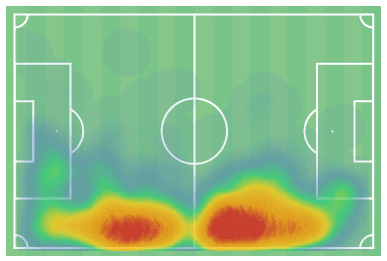
Kyle Walker-Peters heatmap 2019/20
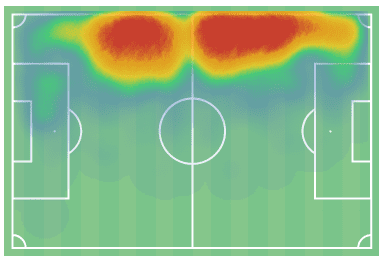
Ryan Bertrand heatmap 2019/20
This tactical versatility is also due to Hasenhüttl’s ambition to not focus on build-up play. He prefers not to play possession-based football, instead of looking to play long, direct balls and get the ball up into the attacking third and further up the pitch as soon as possible, creating as many goalscoring opportunities as possible. This is a clear example of how Hasenhüttl likes to play and use the ball effectively in the four phases of play. Southampton was attempting 47.6 long passes per 90 minutes last season, only four sides averaged more. Whilst this statistic stands them out as a versatile attacking force, the higher their long ball numbers are, the less accurate their passing will be, and they ranked 19th in terms of passing accuracy at the end of the season, with 79%. Whilst Hasenhüttl is not looking for possession-based football, this will be an area he wishes to improve in the future, with increased passing accuracy in his counter-press inevitably leading to more goalscoring opportunities.
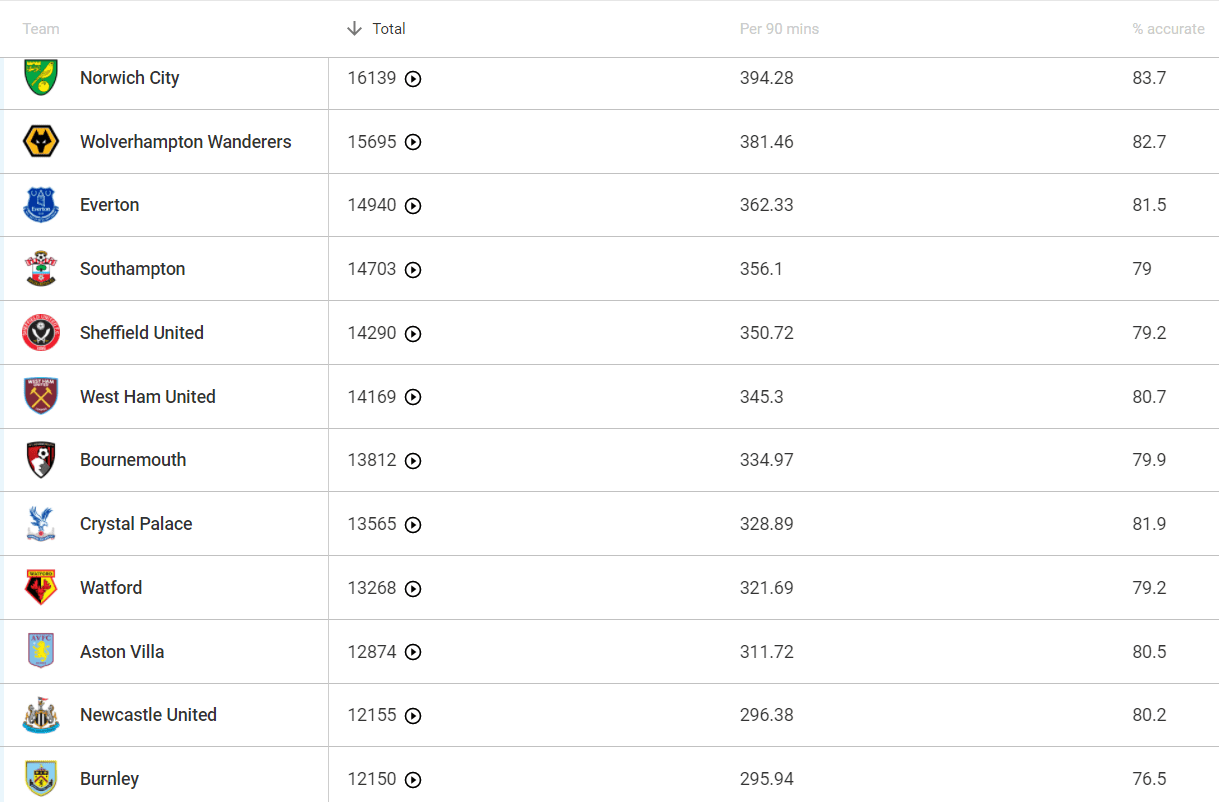
Total number of passes, passes per 90 and passing accuracy 2019/20 Premier League
When discussing the phase ‘against the ball’, it is important to immediately note the key principle to this system, the high press at a high intensity. This ‘gegenpressing’ system that both Jürgen Klopp and Hasenhüttl typically abide by is renowned and frequently used in world football these days. In its simplest terms, ‘gegenpressing’ is the German term for ‘counter-pressing’, and it requires players to immediately press and attempt to win the ball back, not re-grouping into their tactical structure right away. This is why Hasenhüttl is often referred to as ‘the Alpine Klopp’, although understandably, he is not particularly fond of this name, as he has his principles that set him apart from Klopp.
When the opposition wins the ball back from Southampton, in this system, the team is coached and primed to counter-press aggressively, looking to regain possession of the ball as quickly as possible and ideally, if it is the case, in dangerous areas of the pitch, inside the opposition half. This pressing is highly useful for Southampton to play progressive attacking football and disorientate sides who don’t press or play at the same speed. It is a system which requires high levels of energy and defensive awareness that is followed by clinical and quick attacking play. The images below showcase Southampton pressing high and in high numbers as well, with them overwhelming the opposition players in dangerous areas of the pitch, in order to win the ball back immediately to begin a counter-attack.
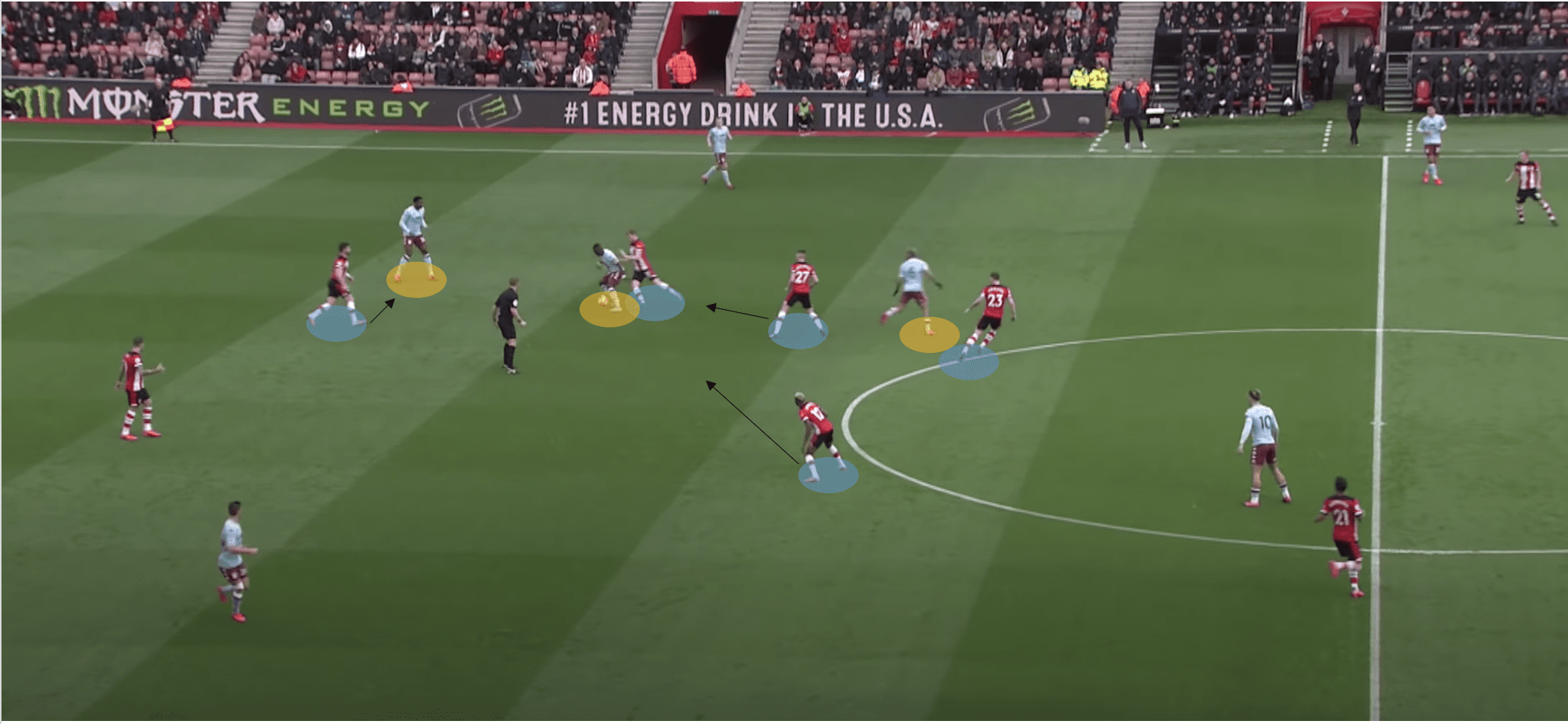
Southampton pressing high and aggressively to win ball back in opposition half
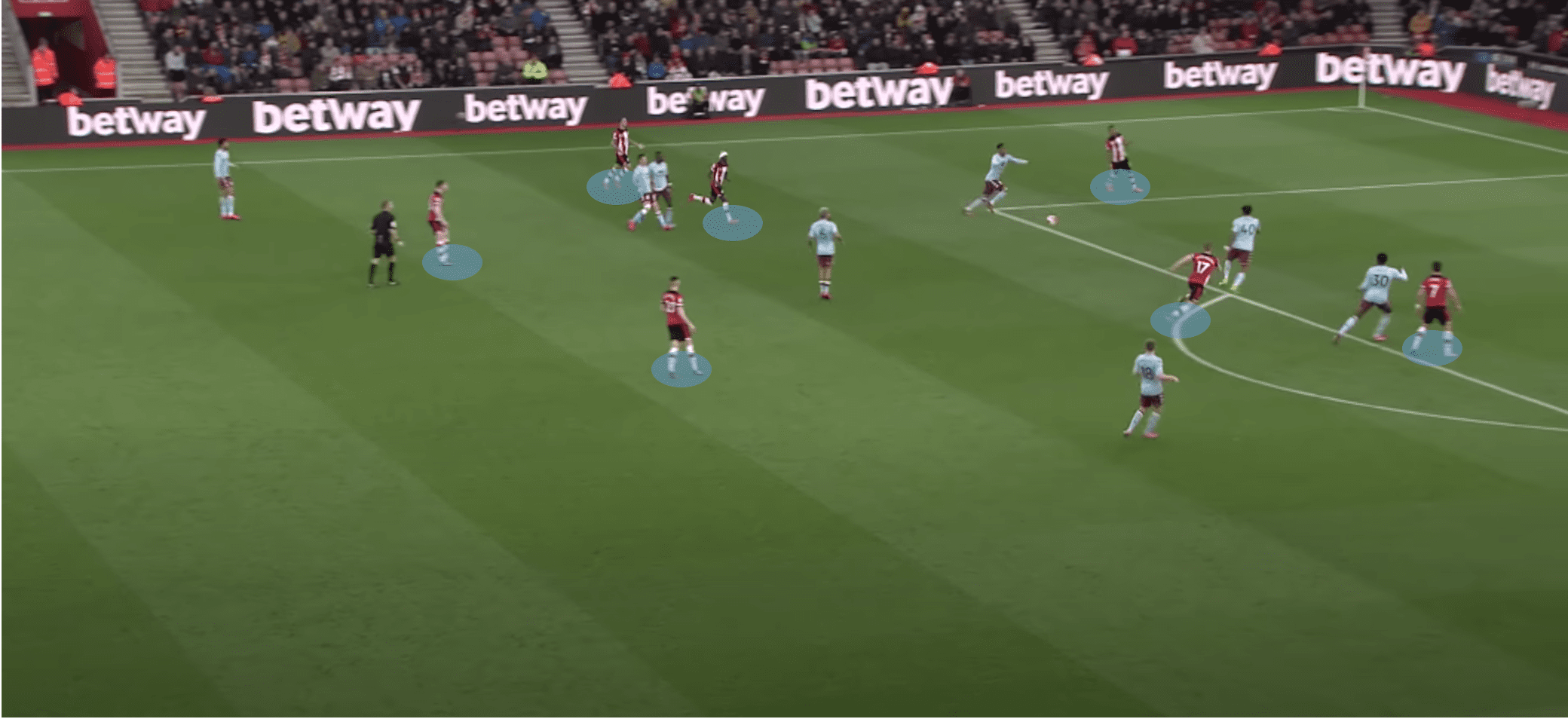
Southampton overloading zonally in dangerous areas
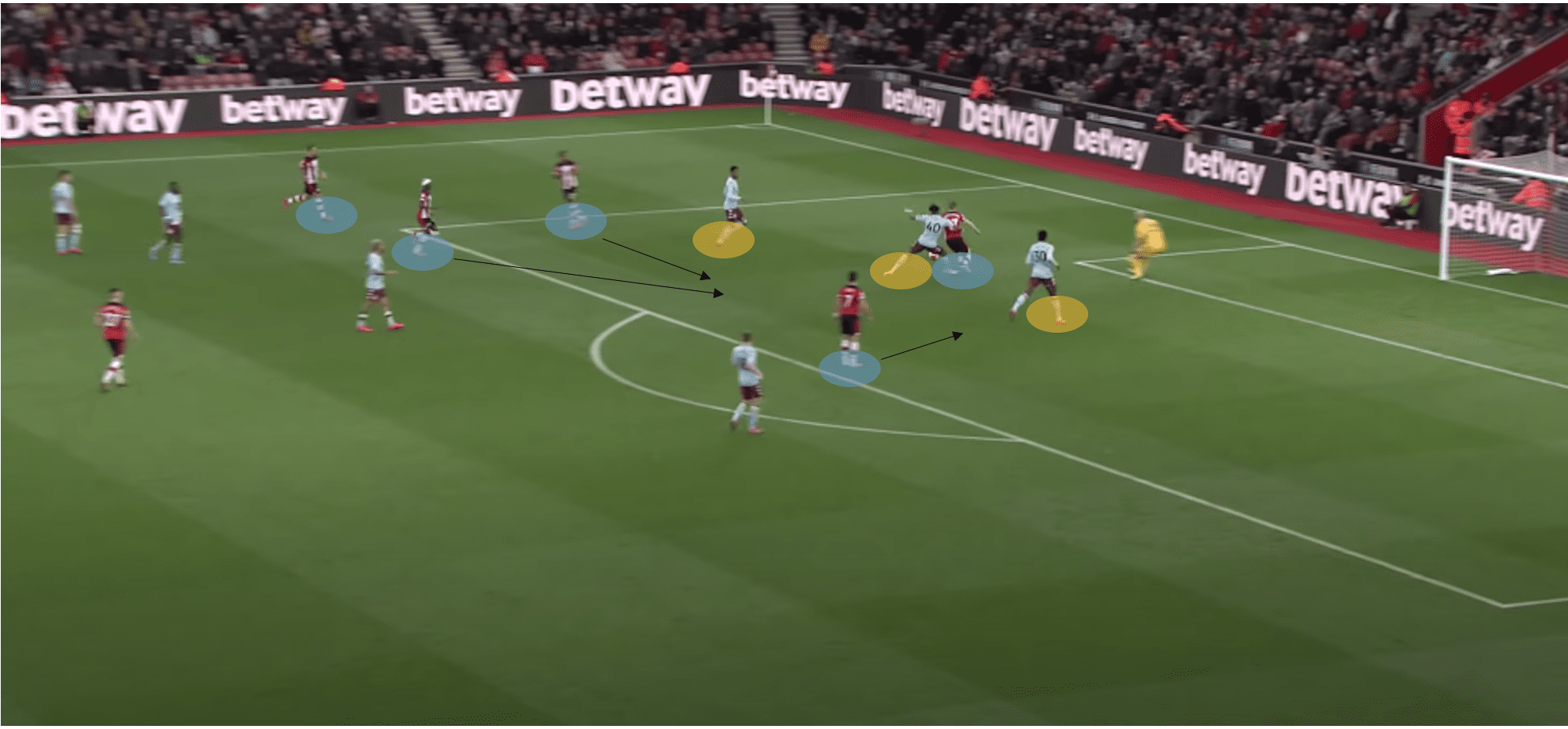
Southampton win ball back and are immediately prepared to react
This makes Hasenhüttl’s 4 phases fluid and open, meaning that as soon as they are against the ball, they press hard to win it back, use the ball and play it effectively. This attacking intensity shows with their xG (expected goals) ranking of 7th in the league at the end of the season, showing them to be expected to score more goals and win more games than their league table position of 11th suggests.
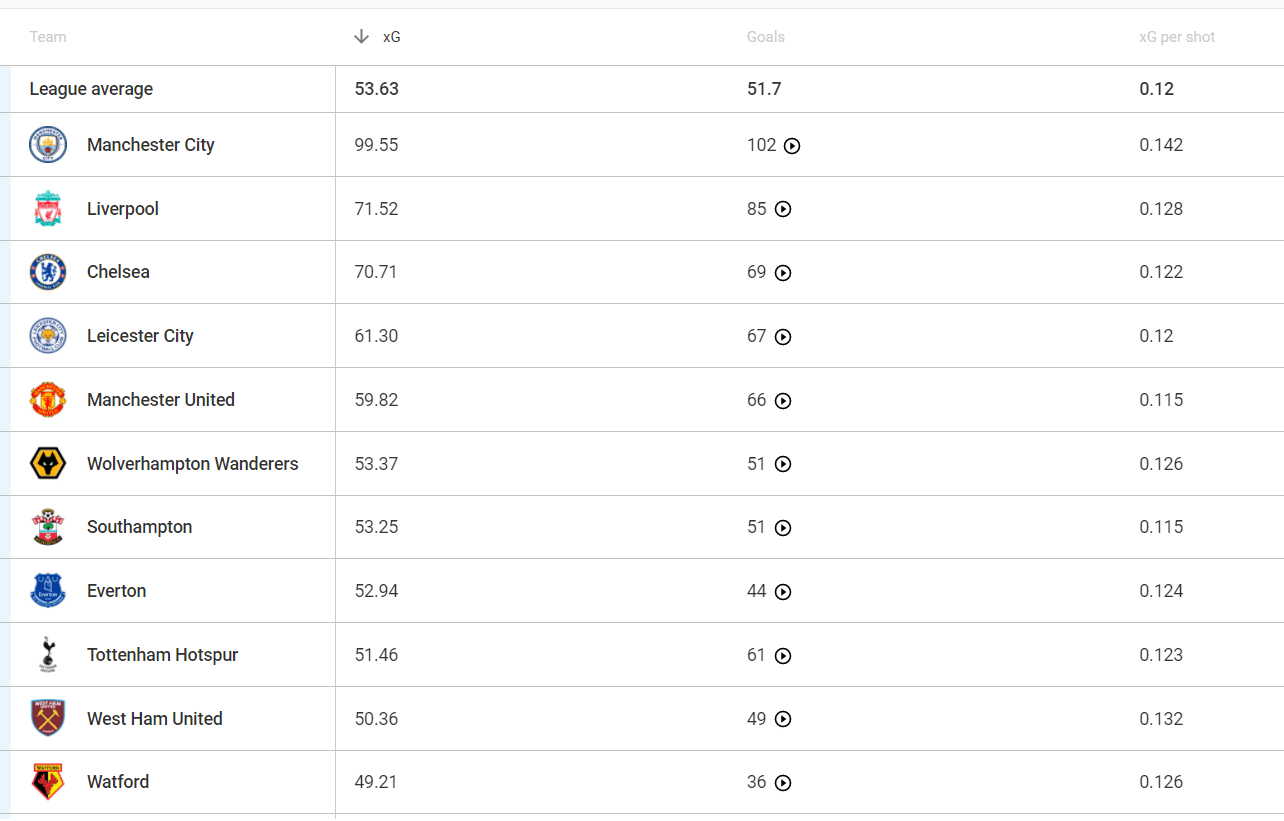
xG rankings 2019/20 Premier League
This bold and aggressive style of play has left teams open and vulnerable, meaning Southampton have gone from being a seemingly ‘nice’ side to play against, particularly at St. Marys, to a team that frustrate their opponents consistently throughout the game. Saying this, their home form has yet to improve, and this is something Hasenhüttl needs to address going into the new season as a priority as well. Statistically, Southampton’s PPDA (passes per defensive action) sat at 9.79 by the end of last season. The PPDA measures how often a team disrupts an opponent’s passing play so the lower the number is, the fewer passes a team can string together against a side. Southampton had the 5th lowest PPDA in the whole league last season, showcasing their ability to press and frustrate other teams effectively. Hasenhüttl believes Southampton’s play starts without the ball. This phase of play is essential for his tactics to succeed.
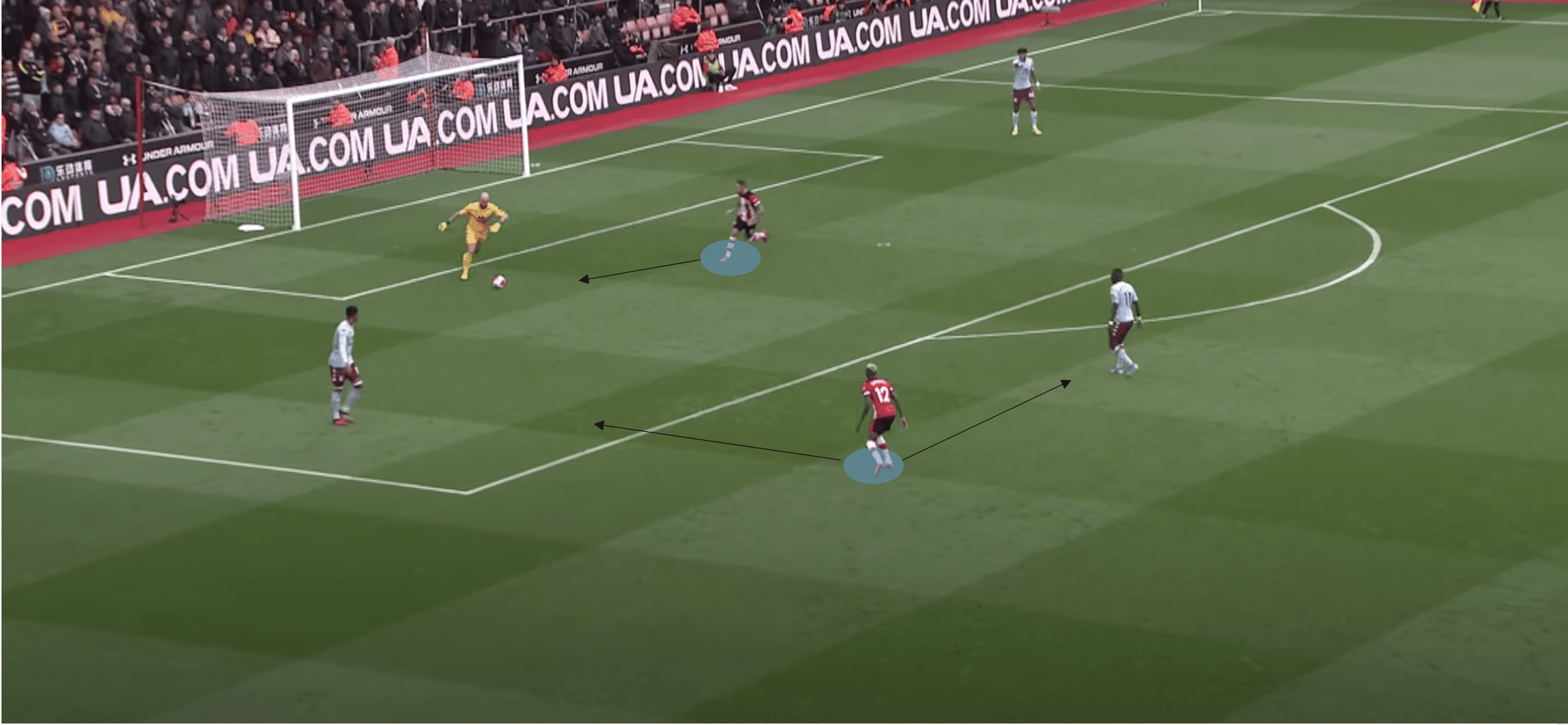
Southampton’s forwards pressing high and aggressively
The image above perfectly showcases this, with the Southampton players pressing even when Aston Villa are beginning their play through their goalkeeper, Pepe Reina, forcing his hand to go long with the ball as it is simply too risky for him to try and pass short to one of his defenders. This long ball was then snuffed out quickly by Southampton players pressing further up the pitch, starting another counter-attack.
One potential weakness of such a high press is the gaps left in behind if the opposition team are to find their way through. There is an imbalance in Southampton’s play at times when their press is opened up by direct or long balls over their pressing lines. The central positioning of their wide players often leaves gaps for wing backs and wingers to capitalise on and the high positioning of their midfielders on the press often leaves the central defenders in their side alone and vulnerable to the opposition attack, often only able to stop themselves from conceding through winning one-on-one battles. The two images below showcase the dangers of such a high and aggressive counter-press, with many Southampton players being far too high up the pitch, having to recover their positions as the opposition counter fast desperately. On this occasion, they avoided conceding, but again a stronger side, they may have found themselves caught out.
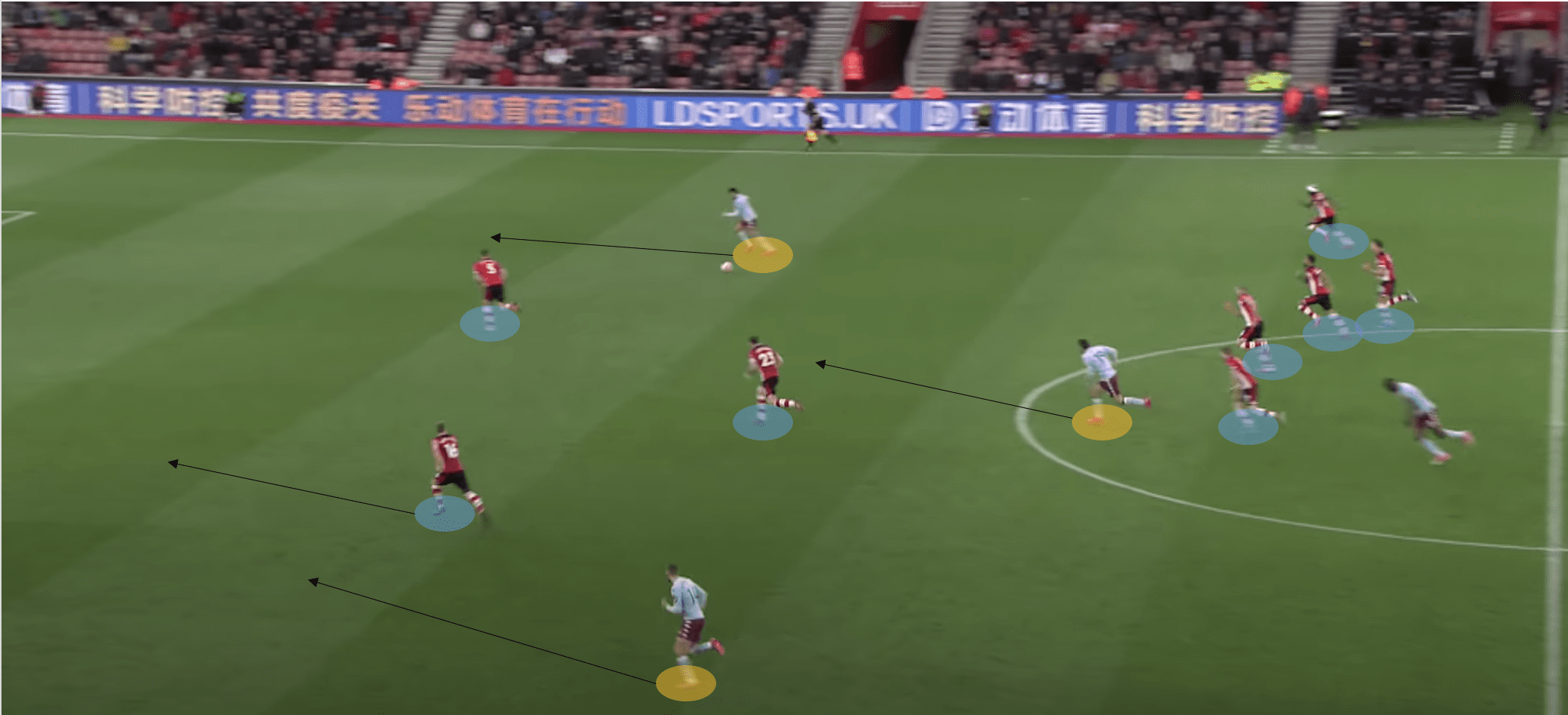
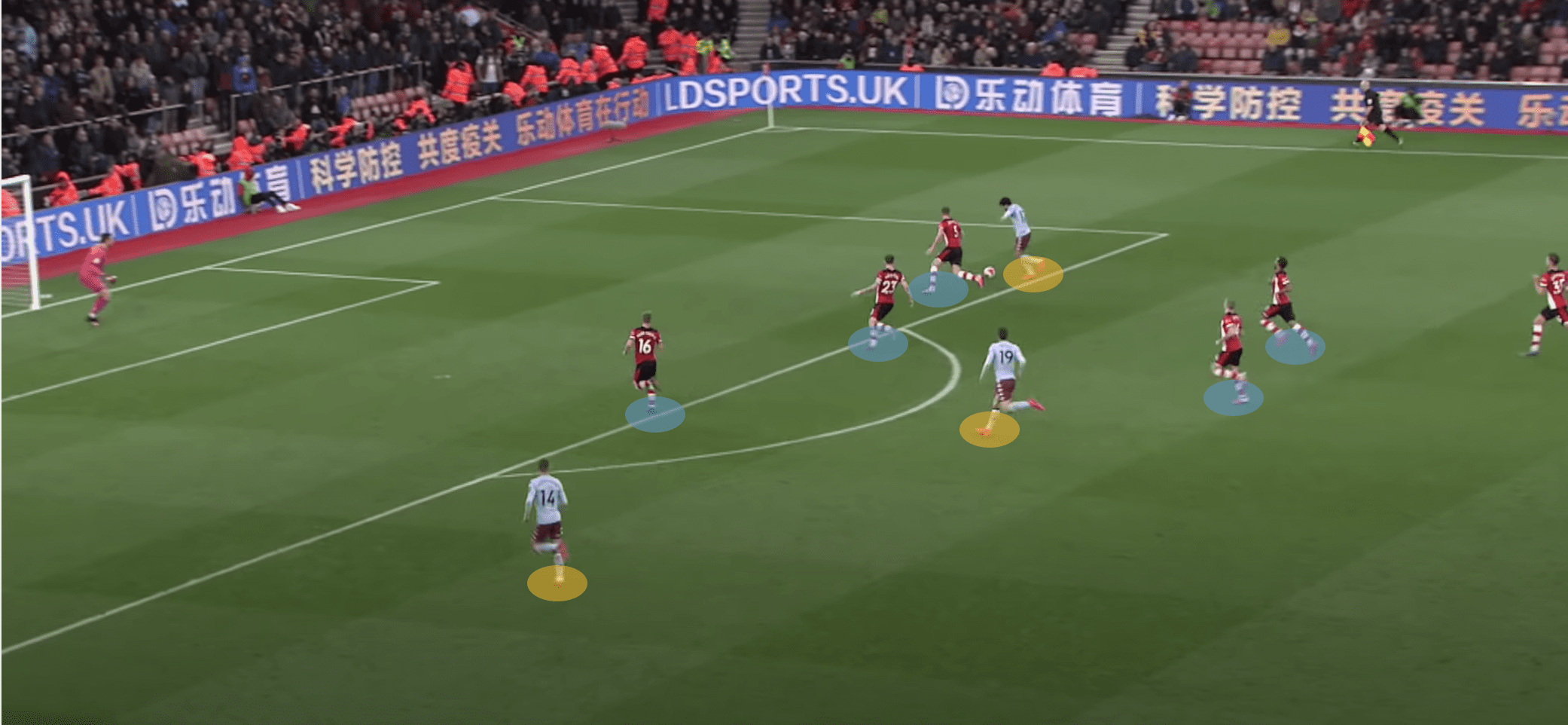
Another weakness of the 4-2-2-2 system deployed by Hasenhüttl is the vulnerability on the wings when the wide midfielder cuts inside. At times last season, Redmond would find himself in an awkward position, making an attacking run that leaves a gap in the wide areas, often leaving the full back up against at least two opposition players, especially if they are aware of the numerical advantage they would have if they catch the wide midfielders out. In Hasenhüttl’s system, the wide midfielders need to be exceptionally tactically intelligent, to have any chance of keeping their place in the side.
Hasenhüttl has learned a thing or two from his Leipzig days, however. One way in which his Southampton side differs from his Leipzig side is that Southampton has less of a tendency to dive into tackles one-on-one, instead, being patient and keeping players behind the ball as frequently as possible. This is the danger of the 4-2-2-2 system, it is reliant on players with the energy to press frequently whilst also not finding themselves too out of position. Positional intelligence matched with energy and commitment in winning the ball back is a combination that isn’t easily mastered, but Southampton are committed to this system, and so far, they are finding a way of making it work.
A key component of their increased success in recent weeks has been the individual improvements and adaptations to the new ‘playbook’ philosophy. No player has shown their adaptation more than their captain, James Ward-Prowse. He has become a more physically demanding player, looking to outmuscle opposition more frequently, playing deeper and becoming a burden for the opposing players to deal with. He puts in the shift by fighting to win the ball back deep in his own half, progresses the ball forward and in many cases, using his attacking nous to join in on a counter-press. He is no longer just a set-piece specialist for Southampton. He provides a calling card as to what is expected of any Southampton player or incoming Southampton player.
Summary
During this analysis, what has become clear is that the identity of Southampton is returning. Hasenhüttl had brought stability, but now he and the team simply want more. They want to push into the top half of the league and begin challenging for Europe, and the SFC playbook is a key ingredient to this becoming reality, in the short term and in the long. A reboot of Southampton’s style of play, youth system and coaching style has been key to them turning things around, and with Hasenhüttl seemingly here for the project long term, if they can keep him that is, they will continue to be a success for years to come. Rather than buy in talent, Hasenhüttl wants to grow talent through the system by bedding them into his ideals. He wants to give them that chance to succeed, and so far, even without the playbook, it has been achievable. Southampton has an intriguing year to come.

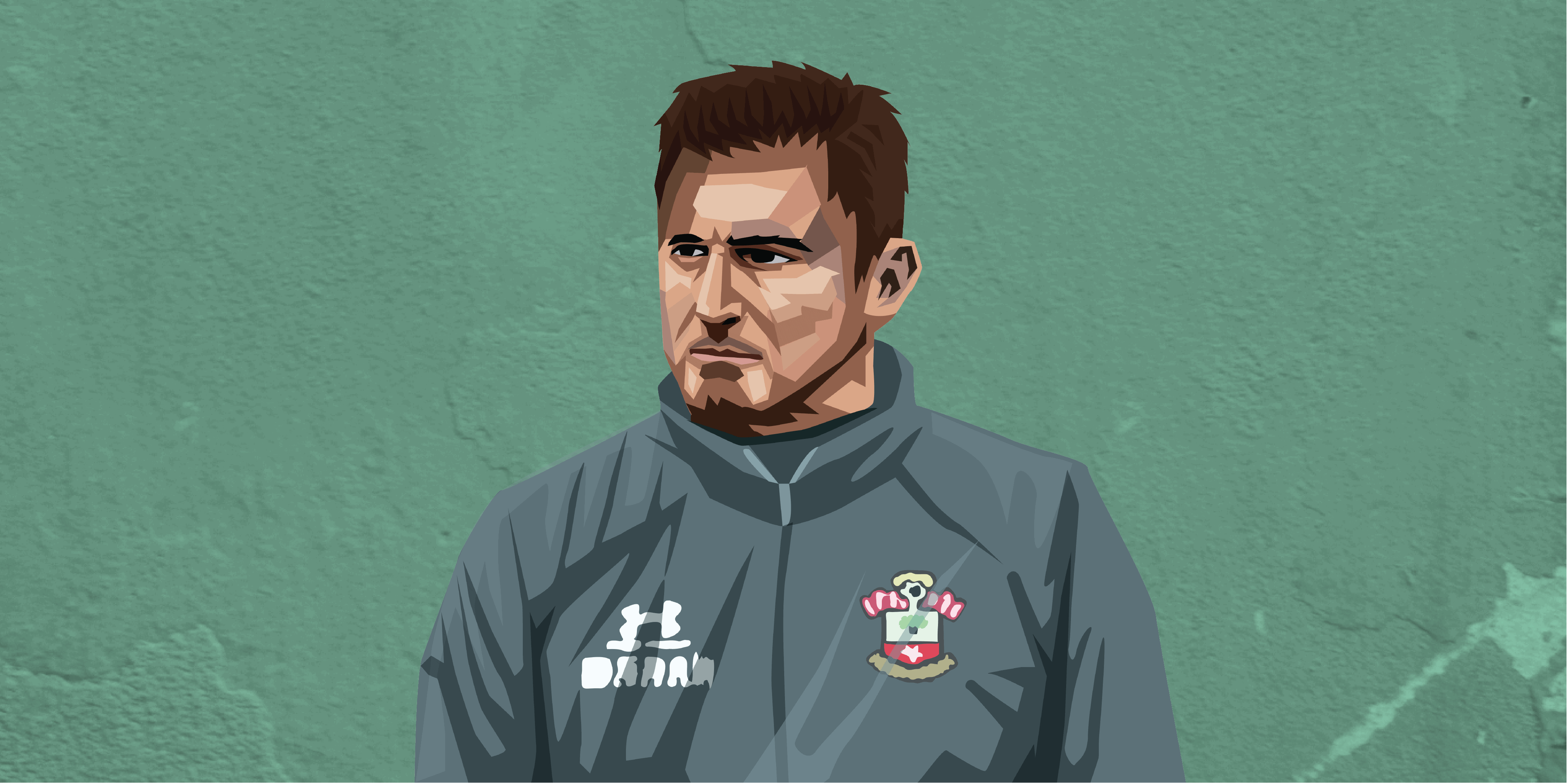



Comments